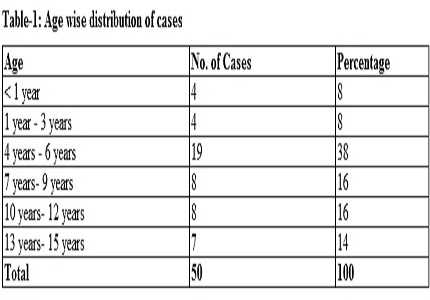Clinical and epidemiological study of scorpion sting envenomation at a teaching hospital in rural Telangana
Abstract
Introduction: Scorpions have adapted to diverse environments and are mainly found in tropical and sub- tropical countries, between latitude 50 N and 50 S. Scorpion stings are primarily due to accidental contact with scorpion. Scorpions capable of inflicting fatal stings in humans are all members of families Buthus and Scorpionidae. Reports from Bellary, Rayalaseema, rural Maharashtra, Pondicherry and Chennai have documented such fatalities in children and adults. This study was done to know the clinical presentation, course, complications and outcome of scorpion sting envenomation. To study the epidemiology and circumstances leading to scorpion sting in the community.
Materials and Methods: 50 cases of scorpion sting, admitted to Mamata General Hospital, Khammam from October 2010 to October 2012 were included in the study. On admission, a detailed clinical history, including the time of sting, symptomatology, details of treatment received before admission was taken. Further a description of the scorpion and details about the circumstances leading up to the sting were obtained.
Results: Maximum numbers of cases were noted in the age groups of 4-6 years. Scorpion sting were more common in males. Maximum number of cases were seen in rainy and in the summer season. Stings due to Mesobuthus species (Red scorpion) were slightly more common than stings due to Palamneus species (Black scorpion).
Conclusion: Scorpions have been known to man since time immemorial and have a significant presence in mythology and human history. Scorpion stings, once considered just a painful nuisance have now got the attention and care that they deserve. Early and effective prazosin therapy, good supportive care, close monitoring and management of complications can limit the resulting morbidity and mortality significantly. The role of scorpion antivenom still remains controversial.
Downloads
References
2. Mahadevan S. Scorpion sting. Indian Pediatr. 2000 May;37(5):504-14. [PubMed]
3. Himmatrao SalubaBawaskar, Pramodini Himmatrao Bawaskar. Scorpion Sting: Update. JAPI January 2012;60(1):46-55.
4. Mahaba HMA. Scorpion Sting Syndrome : Epidemiology, clinical presentation and management of 2240 cases. Eastern Mediterranean Health J 1997;3(1):82-89.
5. Mahadevan S. Scorpion Sting. In: Principles of Pediatric and Neonatal Emergencies. Sachdev HPS, Choudhury P, Bagga A, Chugh K, Ramji S, Puri RKedt.,2nd edn., Jaypee Brothers; New Delhi: 2003,p.409-15.
6. Bawaskar HS, Bawaskar PH. Indian red scorpion envenoming. Indian J Pediatr. 1998 May-Jun;65(3):383-91. [PubMed]
7. Biswal N, Bashir RA, Murmu UC, Mathai B, Balachander J, Srinivasan S. Outcome of scorpion sting envenomation after a protocol guided therapy. Indian J Pediatr. 2006 Jul;73(7):577-82. [PubMed]
8. Cheng D, Dattaro JA, Yakobi R. Scorpion sting.Cited on 2005 June 23; 24 screens: Available from: www.emedicine.com/med/topic 2081.html
9. Santhanakrishnan BR, Gajalakshmi BS. Pathogenesis of cardiovascular complications in children following scorpion envenoming. Ann Trop Pediatr1986;6(2):117-121.
10. Kulkarni ML, Anees S. Snake venom poisoning: experience with 633 cases. Indian Pediatr. 1994 Oct;31(10):1239-43. [PubMed]
11. Adiguzel S, Ozkan O, Inceoglu B. Epidemiological and clinical characteristics of scorpionism in children in Sanliurfa, Turkey. Toxicon. 2007 May;49(6):875-80. Epub 2007 Jan 10. [PubMed]
12. Santhanakrishnan BR. Scorpion sting. Indian Pediatr. 2000 Oct;37(10):1154-7. [PubMed]
13. Bogomolski-Yahalom V, Amitai Y, Stalnikowicz R. Paresthesia in envenomation by the scorpion Leiurus quinquestriatus. J Toxicol Clin Toxicol. 1995;33(1):79-82. [PubMed]
14. Bawaskar HS, Bawaskar PH. Clinical profile of severe scorpion envenomation in children at rural setting. Indian Paediatr 2003; 40(11):1072-1076.
15. Bawaskar HS. Management of severe scorpion sting at Rural settings: What is the role of scorpion antivenom? J. Venom Anim Toxins incl Trop Dis 2005; 11(1):3-7.
16. Bawaskar HS, Bawaskar PH. Prazosin in the management of cardiovascular manifestations of scorpion sting. Lancet 1986;1(8479):510-11. [PubMed]
17. SinghalA., MannanR., RampalU. Epidemiology, clinical presentation and final outcome of patients with scorpion bite. Journal of clinical and diagnostic research 2009; 3(3):1523-1528.

Copyright (c) 2017 Author (s). Published by Siddharth Health Research and Social Welfare Society

This work is licensed under a Creative Commons Attribution 4.0 International License.


 OAI - Open Archives Initiative
OAI - Open Archives Initiative


